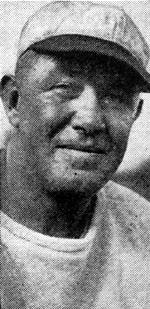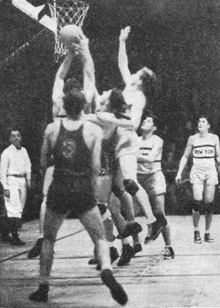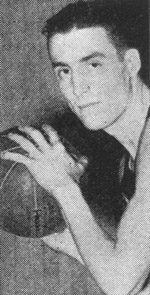![]()
In a Sport With Confusing Rules and Long Dominated by the Middle West, New York University, Undefeated in Twenty-Seven Games, Makes a Bid for Coronation
Published in Literary Digest Magazine, February 9, 1935, pg. 40
![]()
A startling discovery has been made in New York this winter. The discovery is college basketball gone big-business with the inevitable concomitants -- 48,000 spectators paying in excess of $60,000 for the first three of seven double-headers in Madison Square Garden; intersectional games; the hitherto mythical national championship assuming definite form; the gambling gentry showing a sudden affection for basketball to accommodate their baseball, hockey and boxing clients; bitter recriminations.
 |
| Mentor: Howard Cann |
Coach Adolph Rupp of Kentucky charged, in effect, that his team had been robbed, that "with a Western Conference official working the game we'll beat N.Y.U. by thirty points, at Lexington or anywhere else." Pistols for two and coffee for one. Jack Murray, top-ranking official of the Eastern Intercollegiate Association and the referee who called the deciding foul, declared that the play "was a deliberate block," that "it is to be regretted that Kentucky is taught illegal block plays."
Troublesome Pivot Play
The Eastern interpretation of the pivot play was the direct cause of all the trouble in the Garden. The Notre Dame and Kentucky teams which were imported to play smooth N. Y. U. seemed to have built their entire attacks around a big center stationed on the foul-line with his back to the basket. Both teams were disorganized when Irwin Klein and Irving Terjesen, the N. Y. U. defensive players, used the strong-arm tactics permitted in the East to stop the play.
Marty Peters, the Notre Dame pivot, was limited to two field-goals as the Irish were trounced, 25-18. Leroy Edwards, of the Kentucky team, the 6-foot, 4-inch sophomore who had scored 26 points against Chicago to maintain his all-time scoring average of twenty points a game, "was held -- but held! -- to exactly one field-goal.
Notre Dame had no alibis for its defeat. Frank Lane, a prominent Mid-West official, was the referee and called the personal fouls which disqualified Klein and Terjesen -- to the loud accompaniment of outraged screams from the East.
The Kentucky affair was something else again. Murray and Dave Walsh, also of the E. I. A., arbitrarily told the Kentucky captain, Dave Lawrence, what they regarded as legal and illegal maneuvers. The Southerners had no time to alter their plan of operation and were lost when the pivot, the climax of their eleven set plays, was not interpreted as they had learned it.
Eastern Aspirant
Since all beleaguered parties concerned find it impossible to effect standardization of concrete material such as a playing code, it is hardly to be expected that the nebulous national championship will be generally conceded to one team without another exchange of harsh language. Rated off the record, which has a fine disregard for technical considerations, it seems that N.Y.U. has the strongest claim for the title.
Granting the merits of Kentucky's stentorian protest, N. Y. U. still dominates the national situation. Notre Dame, conqueror of Stanford by ten points, and shaded only by powerful Northwestern by one slim point before playing N.Y.U., was beaten pretty decisively by the Violet under conditions which were more than favorable. That would seem to take care of the Middle West and Far West. Kentucky, Southeastern Conference champions and unquestionably the class of the South, was outscored from the field, 9-8, by a better team, altho it had the better athletes. In its own Eastern sector, N.Y.U. snapped the ten-game streak of Temple, victor over Pitt, by the overwhelming margin, of 38-22.
 |
| Unbeaten, New York University adds another victory to the list of twenty-seven -- this one over ten-game Temple University |
Virtually all of N.Y.U.'s successes, this season and last, have been intellectual as well as physical triumphs. Altho Howard Cann's team averages 6:1 perpendicularly, it was forced to give away crushing advantages in weight and height to Notre Dame, Kentucky and Temple. It did not control the tap at center in any game and usually lost possession of the ball off the backboard, but reduced all opponents to its own size by sheer finesse and imagination.
 |
| High-scorer: Willie Rubenstein |
And N.Y.U., always known as a strong finisher, can turn on the heat. Notre Dame and Kentucky left the court leading at halftime. The Irish were buried under an uninterrupted ten-point avalanche in the second half and Kentucky, leading by four points with five minutes to go, "was shut out the rest of the way, while N.Y.U. scored just enough to win. Temple was ahead, 7-1, early in its Garden appearance, but, in company with all others, wilted badly, and was trailing, 19-13, at the intermission.
They Make the Team
Capt. Sid Gross, the only graduating senior among the first nine men, is the "digger" of the Violet. Willie Rubenstein, the high-scorer, is perhaps the most polished, artistic, and erratic player. Two aggressive sophomores, Len Maidman and Milt Schulman, have really made the team. Klein, an amiable clown, and Terjesen divide the center-assignment.
But none of them will ever be the basketball player, or all-around athlete, that Coach Cann was. He was the star of the 1920 N.Y.U. team which won the A.A.U. title at Atlanta. He was I.C.A.A.A.A. shot-put champion in 1917 and '20; placed sixth in the Olympics. Weighing 195 pounds and fast enough to run the high hurdles in 16 seconds, Cann was a devastating runner with a football, N.Y.U.'s best until the advent of All-America Ken Strong.
![]()
Return to Kentucky Basketball page, statistics, team schedules, team rosters, opponents, players, coaches, opposing coaches, games, assistance or search this site.
![]()